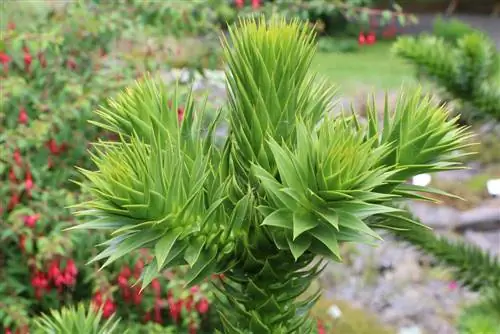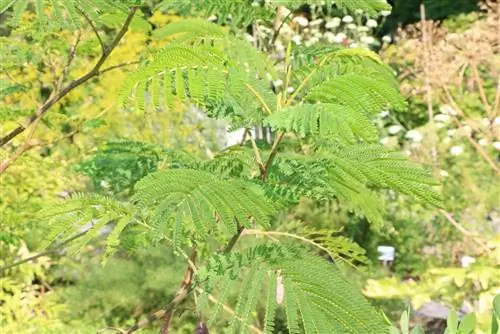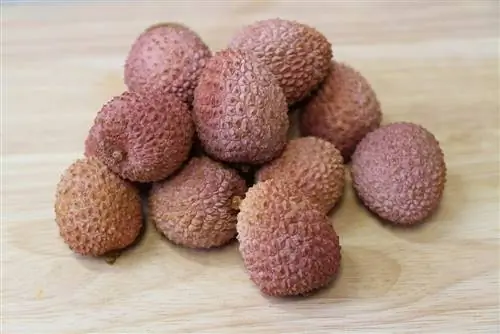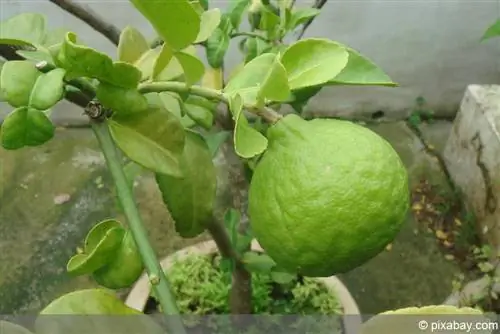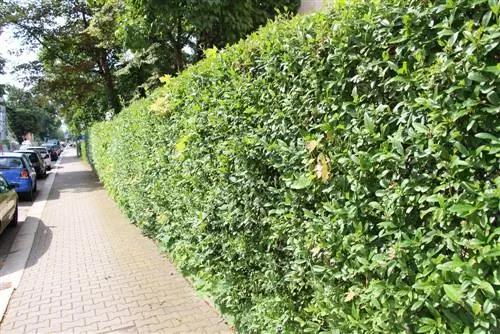- Author admin [email protected].
- Public 2023-12-17 03:39.
- Last modified 2025-01-24 12:45.
Monkey tree, Chilean fir or araucaria - as the plant is also called, it is an eye-catcher in the garden. The tree can grow up to five meters high and four meters wide, making it an impressive sight. The exotic look is created by triangular needles and circularly arranged branches that grow horizontally. But what is important when it comes to care?
Location
Finding the right location for the monkey tree is not that easy. On the one hand, the Chilean decorative fir needs a very bright planting location with sufficient light. On the other hand, it cannot tolerate winter sun. A protected planting location to the north or west would therefore be suitable, where only morning and evening sun but no blazing midday sun falls on the plant.
You should also make sure there is enough space. Although Araucaria grows slowly, it can reach a height of five meters. Three to four meters in width are possible. Male specimens generally remain smaller than female monkey trees. However, it should not be planted too close to house walls, fences or other plants. This is particularly important because the Chilean fir should not be cut.
Substrate
The ideal substrate for the monkey tree should meet the following factors:
- moist with good water storage properties
- permeable
- slightly sour
- moderate nutrient content
- low lime content

Commercial garden soil can be used as long as it does not have too high a lime content. If the soil in the garden tends to become compacted, it can be loosened up with gravel and sand and the water drainage improved. If the soil does not retain enough moisture, coconut fiber can be mixed in instead. On the one hand, these serve as water storage and also loosen the soil.
Planting
Araucaria can be cultivated both outdoors and in containers. If the Chilean decorative fir is to be grown outdoors, planting it after the last ground frost is crucial. The plant should therefore be used in late spring or early summer, depending on the region.
This means there is still enough time for growth and hardening, but damage from ground frost is no longer to be expected.
Pouring
During drought, not only does the growth of the monkey tree suffer, it also develops yellow and brown discolorations very quickly. However, the plant also cannot tolerate waterlogging. When watering, the following points should therefore be taken into account:
- Use low-lime, soft water
- Watering, especially in hot, dry weather
- if necessary, water on frost-free days in winter
- let the top layer of soil dry thoroughly before watering
Since low-lime water should be used, collected rainwater or pond water are ideal. If there are not sufficient quantities of this, soft tap water can also be used. In areas with lime-rich tap water, it helps to let the water sit for a few days or a week before watering. This causes the lime to collect at the bottom of the vessel.
Fertilize
Araucaria has only low nutrient requirements. During the growth phase, approximately from March to September, it is sufficient to administer a small amount of liquid fertilizer every four to eight weeks. The less nutrient-rich the substrate is, the shorter the intervals between fertilizer applications should be.
The additional supply of nutrients begins when the first new shoots appear on the branches.
Bucket Culture
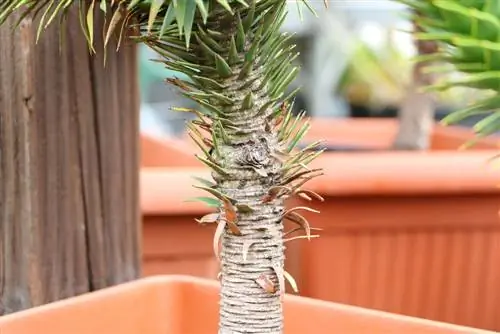
The monkey tree can also be cultivated in a pot, at least for the first few years. However, there are some differences to outdoor cultivation in terms of care and especially when it comes to watering and fertilizing. The differences are:
-
Choose a suitable planter:
The bucket should be stable and of sufficient size so that the monkey tree cannot tip over. The Araucaria grows slowly, but can gain considerable weight. It therefore makes sense to place the pot on a plant roller or choose a plant pot with rollers.
-
Water regularly but avoid waterlogging:
To avoid waterlogging, a drainage layer should be placed in the plant pot. This can prevent the roots from standing in water, even with a high saucer or planter. It is also important that the root ball never dries out completely. Only the top layer of soil should be allowed to dry before the next watering. In summer, watering once a week or even several times a week may be necessary. Even in winter, the substrate should never dry out completely.
-
Fertilize more frequently:
While fertilization every four to eight weeks is sufficient outdoors, the Chilean fir in container cultivation should be supplied with additional nutrients every two weeks. Low doses of liquid fertilizer are ideal. Again, fertilization should only be carried out during the growth phase between March and September.
-
Repotting:
Repotting or changing the soil should be done if the pot cannot provide sufficient stability, the soil is used up or roots appear at the bottom of the pot. Experience shows that this only happens after two to three years.
-
Overwintering:
If the Chilean fir is cultivated in a pot, it should not be overwintered outdoors. Since there is less substrate available, frost damage to the roots could occur. Instead, overwintering should take place in a bright room at around 5°C. Watering continues, although only small amounts of water should be given at a time.
Blend

Basically, the monkey tree does not need any waste. In addition, the decorative shapes appear more quickly if this measure is omitted. However, if necessary, pruning can be carried out.
However, make sure that:
- Branches are cut off directly on the trunk and branches are cut off directly on the original branch
- no stubs left standing
- cutting only takes place on warm, dry days
- only clean cutting tools are used
Twigs and branches should not only be partially shortened, but if trimming is necessary, completely removed. Only then does cutting pose no disadvantage or risk of promoting disease.
Tip:
Cutting should be done when neither frost nor extremely high temperatures are expected. Suitable times are late spring or early autumn.
Propagation
The propagation of the monkey tree requires some patience because it is done using seeds from the ripe cones. However, the Chilean ornamental fir only blooms after about 30 years, so collecting seeds in your own garden is comparatively difficult. Seeds from specialist retailers are an alternative.
To germinate the seeds, proceed as follows:
- The seeds from ripe cones or from specialist retailers should not be dried before they are placed in potting soil. After training in the fall, these can be extracted directly from the cones.
- The substrate is kept moist, but should not be wet. By covering the planters with a glass pane or foil, evaporation can be reduced. However, the cover should be removed daily for a short period of time to avoid mold formation.
- The planters are placed in a bright and moderately warm place. A germination temperature of around 18°C to 20°C is ideal.
- After about four months they should show the first shoots. From late spring onwards, the young plants can be planted outdoors.
An alternative to this is direct sowing outdoors. The seeds are placed directly in the fall in the desired planting location and covered with soil.
Tip:
Seeds from local specimens of the monkey tree are usually the best choice, as the plants are more hardy.
Wintering
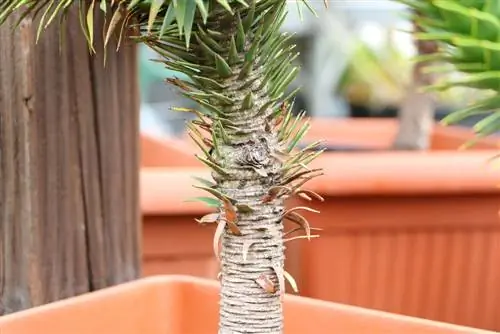
Araucaria is partially hardy and should be protected from severe ground frost. Wintering outdoors is still very easy. Protective materials are simply placed on the floor pane. Brushwood, straw, mulch and pine branches are suitable for this. Jute or special protective films can also be used.
This protective layer is intended to prevent the soil from freezing completely, thereby allowing the roots to continue to absorb water. When growing in a pot, the plant must be frost-free but still bright. In addition, the earth should not dry out even in winter. If necessary, small amounts of water can be given on frost-free days.
Diseases and pests
The monkey tree is largely resistant to both diseases and pests. However, care errors can cause problems. Typical examples include:
Root rot
Waterlogging and soil that tends to compact can cause or promote root rot. The risk of other fungal diseases also increases if the water can only drain insufficiently.
Drought damage
Inadequate water supplies can occur in both hot, dry weather and ground frost. The result is discoloration and death of the needles and shoots.
Frost Damage
The monkey tree is hardy if it is planted outdoors in good time and can grow before the first frost and receives sufficient protection, but frost damage can still occur. These mainly occur in connection with drought damage. If the ground is frozen, the roots cannot absorb water. It is therefore important, on the one hand, that appropriate protection is applied to the ground and, on the other hand, that it is watered on frost-free days.
Burns
Bright midday sun can cause burns, especially in winter. The only way to prevent this problem is to select the appropriate location.
Tip:
Adapted care can prevent the problems described.

